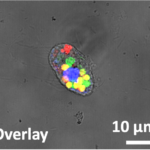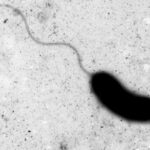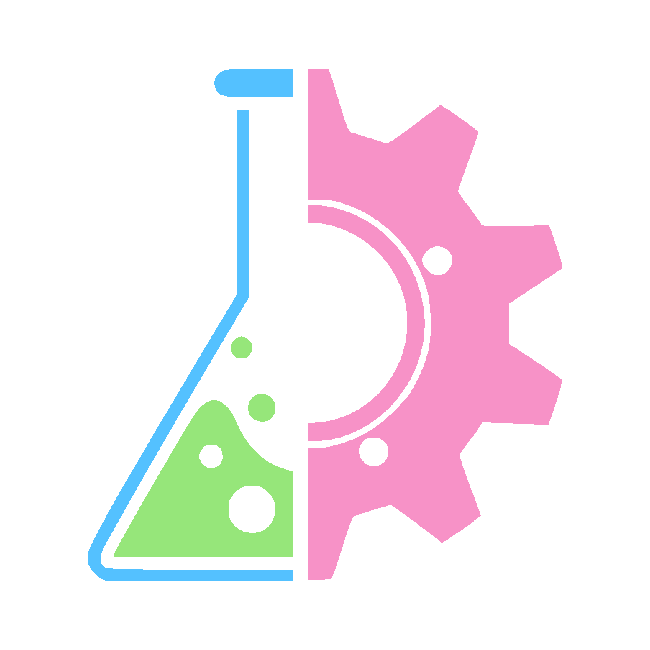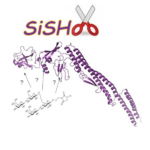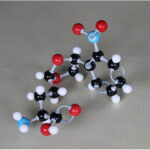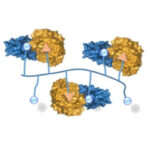La théorie, c'est quand on sait tout et que rien ne fonctionne. La pratique, c'est quand tout fonctionne et que personne ne sait pourquoi. Souvent théorie et pratique se rejoignent : rien ne fonctionne et on ne sait pas pourquoi
A. Einstein

Cyrille GRANDJEAN
Directeur de recherche CNRS
section 12
| Équipe : |
Thèmes de recherche
Concept et développement de vaccins glycoconjugués
Etudes des interactions protéines/sucres
Projets
Parcours universitaire
1986-1990 Diplôme d’Ingénieur de l’Ecole de Chimie Industrielle de Lyon (ESCIL devenue CPE Lyon)
1990 Diplôme d’Etudes Approfondies de Chimie Organique Fine, Université de Lyon I
1991-1994 Doctorat en Chimie Organique, Université de Paris XI (Orsay)
Hémisynthèse d’antibiotiques macrolides à 14- et à 16-atomes à partir de l’érythromycine A et de la tylosine
2006 HDR, Université de Paris XI (Orsay),
Conception et développement de vaccins polyosidiques
Publications
1 publication
Scalabrini, Mathieu; Loquet, Denis; Rochard, Camille; Marie, Mélyne Baudin; Assailly, Coralie; Brissonnet, Yoan; Daligault, Franck; Saumonneau, Amélie; Lambert, Annie; Grandjean, Cyrille; Deniaud, David; Lottin, Paul; Pascual, Sagrario; Fontaine, Laurent; Balloy, Viviane; Gouin, Sébastien G
Multivalent inhibition of the fumigatus KDNase Article de journal
Dans: Org Biomol Chem, vol. 22, no. 28, p. 5783–5789, 2024, ISSN: 1477-0539.
@article{pmid38938184,
title = {Multivalent inhibition of the fumigatus KDNase},
author = {Mathieu Scalabrini and Denis Loquet and Camille Rochard and Mélyne Baudin Marie and Coralie Assailly and Yoan Brissonnet and Franck Daligault and Amélie Saumonneau and Annie Lambert and Cyrille Grandjean and David Deniaud and Paul Lottin and Sagrario Pascual and Laurent Fontaine and Viviane Balloy and Sébastien G Gouin},
doi = {10.1039/d4ob00601a},
issn = {1477-0539},
year = {2024},
date = {2024-07-01},
urldate = {2024-07-01},
journal = {Org Biomol Chem},
volume = {22},
number = {28},
pages = {5783--5789},
abstract = { is a saprophytic fungus and opportunistic pathogen often causing fatal infections in immunocompromised patients. Recently KDNAse, an exoglycosidase hydrolyzing 3-deoxy-D-galacto-D--nonulosonic acid (KDN), a rare sugar from the sialic acid family, was identified and characterized. The principal function of KDNAse is still unclear, but a study suggests a critical role in fungal cell wall morphology and virulence. Potent KDNAse inhibitors are required to better probe the enzyme's biological role and as potential antivirulence factors. In this work, we developed a set of KDNAse inhibitors based on enzymatically stable thio-KDN motifs. C2, C9-linked heterodi-KDN were designed to fit into unusually close KDN sugar binding pockets in the protein. A polymeric compound with an average of 54 KDN motifs was also designed by click chemistry. Inhibitory assays performed on recombinant KDNAse showed a moderate and strong enzymatic inhibition for the two classes of compounds, respectively. The poly-KDN showed more than a nine hundred fold improved inhibitory activity (IC = 1.52 ± 0.37 μM, 17-fold in a KDN molar basis) compared to a monovalent KDN reference, and is to our knowledge, the best synthetic inhibitor described for a KDNase. Multivalency appears to be a relevant strategy for the design of potent KDNase inhibitors. Importantly, poly-KDN was shown to strongly decrease filamentation when co-cultured with at micromolar concentrations, opening interesting perspectives in the development of antivirulence factors.},
keywords = {},
pubstate = {published},
tppubtype = {article}
}
4 publications
Prasanna, Maruthi; Calvino, Rubén Varela; Lambert, Annie; Romero, Maria Arista; Pujals, Sylvia; Trottein, François; Camberlein, Emilie; Grandjean, Cyrille; Csaba, Noemi
Semisynthetic Pneumococcal Glycoconjugate Nanovaccine Article de journal
Dans: Bioconjugate Chemistry, vol. 34, no. 9, p. 1563–1575, 2023, ISSN: 1043-1802, (Publisher: American Chemical Society).
@article{prasanna_semisynthetic_2023,
title = {Semisynthetic Pneumococcal Glycoconjugate Nanovaccine},
author = {Maruthi Prasanna and Rubén Varela Calvino and Annie Lambert and Maria Arista Romero and Sylvia Pujals and François Trottein and Emilie Camberlein and Cyrille Grandjean and Noemi Csaba},
url = {https://doi.org/10.1021/acs.bioconjchem.3c00252
hal-04209406v1 },
doi = {10.1021/acs.bioconjchem.3c00252},
issn = {1043-1802},
year = {2023},
date = {2023-09-01},
urldate = {2023-09-01},
journal = {Bioconjugate Chemistry},
volume = {34},
number = {9},
pages = {1563--1575},
abstract = {Pneumococcal conjugate vaccines offer an excellent safety profile and high protection against the serotypes comprised in the vaccine. However, inclusion of protein antigens fromStreptococcus pneumoniaecombined with potent adjuvants and a suitable delivery system are expected to both extend protection to serotype strains not represented in the formulation and stimulate a broader immune response, thus more effective in young children, elderly, and immunocompromised populations. Along this line, nanoparticle (NP) delivery systems can enhance the immunogenicity of antigens by protecting them from degradation and increasing their uptake by antigen-presenting cells, as well as offering co-delivery with adjuvants. We report herein the encapsulation of a semisynthetic glycoconjugate (GC) composed of a synthetic tetrasaccharide mimicking theS. pneumoniae serotype 14 capsular polysaccharide (CP14) linked to the Pneumococcal surface protein A (PsaA) using chitosan NPs (CNPs). These GC-loaded chitosan nanoparticles (GC-CNPs) were not toxic to human monocyte-derived dendritic cells (MoDCs), showed enhanced uptake, and displayed better immunostimulatory properties in comparison to the naked GC. A comparative study was carried out in mice to evaluate the immune response elicited by the glycoconjugate-administered subcutaneously (SC), where the GC-CNPs displayed 100-fold higher IgG response as compared with the group treated with nonencapsulated GC. Overall, the study demonstrates the potential of this chitosan-based nanovaccine for efficient delivery of glycoconjugate antigens.},
note = {Publisher: American Chemical Society},
keywords = {},
pubstate = {published},
tppubtype = {article}
}
Depienne, Sébastien; Bouzelha, Mohammed; Courtois, Emmanuelle; Pavageau, Karine; Lalys, Pierre-Alban; Marchand, Maia; Alvarez-Dorta, Dimitri; Nedellec, Steven; Marín-Fernández, Laura; Grandjean, Cyrille; Boujtita, Mohammed; Deniaud, David; Mével, Mathieu; Gouin, Sébastien G.
Click-electrochemistry for the rapid labeling of virus, bacteria and cell surfaces Article de journal
Dans: Nature Communications, vol. 14, no. 1, p. 5122, 2023, ISSN: 2041-1723.
@article{depienne_click-electrochemistry_2023,
title = {Click-electrochemistry for the rapid labeling of virus, bacteria and cell surfaces},
author = {Sébastien Depienne and Mohammed Bouzelha and Emmanuelle Courtois and Karine Pavageau and Pierre-Alban Lalys and Maia Marchand and Dimitri Alvarez-Dorta and Steven Nedellec and Laura Marín-Fernández and Cyrille Grandjean and Mohammed Boujtita and David Deniaud and Mathieu Mével and Sébastien G. Gouin},
url = {https://doi.org/10.1038/s41467-023-40534-0
https://dx.doi.org/10.26434/chemrxiv-2023-q3sd8
hal-04246348v1 },
doi = {10.1038/s41467-023-40534-0},
issn = {2041-1723},
year = {2023},
date = {2023-08-01},
urldate = {2023-08-01},
journal = {Nature Communications},
volume = {14},
number = {1},
pages = {5122},
abstract = {Methods for direct covalent ligation of microorganism surfaces remain poorly reported, and mostly based on metabolic engineering for bacteria and cells functionalization. While effective, a faster method avoiding the bio-incorporation step would be highly complementary. Here, we used N-methylluminol (NML), a fully tyrosine-selective protein anchoring group after one-electron oxidation, to label the surface of viruses, living bacteria and cells. The functionalization was performed electrochemically and in situ by applying an electric potential to aqueous buffered solutions of tagged NML containing the viruses, bacteria or cells. The broad applicability of the click-electrochemistry method was explored on recombinant adeno-associated viruses (rAAV2), Escherichia coli (Gram-) and Staphyloccocus epidermidis (Gram + ) bacterial strains, and HEK293 and HeLa eukaryotic cell lines. Surface electro-conjugation was achieved in minutes to yield functionalized rAAV2 that conserved both structural integrity and infectivity properties, and living bacteria and cell lines that were still alive and able to divide.},
keywords = {},
pubstate = {published},
tppubtype = {article}
}
Violo, Typhaine; Lambert, Annie; Pillot, Aline; Fanuel, Mathieu; Mac-Béar, Jessica; Broussard, Cédric; Grandjean, Cyrille; Camberlein, Emilie
Site-Selective Unnatural Amino Acid Incorporation at Single or Multiple Positions to Control Sugar-Protein Connectivity in Glycoconjugate Vaccine Candidates Article de journal
Dans: Chemistry--A European Journal, vol. 29, no. 15, p. e202203497, 2023, ISBN: 1521-3765.
@article{violo2023site,
title = {Site-Selective Unnatural Amino Acid Incorporation at Single or Multiple Positions to Control Sugar-Protein Connectivity in Glycoconjugate Vaccine Candidates},
author = {Typhaine Violo and Annie Lambert and Aline Pillot and Mathieu Fanuel and Jessica Mac-Béar and Cédric Broussard and Cyrille Grandjean and Emilie Camberlein},
url = {https://chemistry-europe.onlinelibrary.wiley.com/doi/full/10.1002/chem.202203497
hal-03918892v2
},
doi = {10.1002/chem.202203497},
isbn = {1521-3765},
year = {2023},
date = {2023-03-13},
urldate = {2023-03-13},
journal = {Chemistry--A European Journal},
volume = {29},
number = {15},
pages = {e202203497},
publisher = {Wiley Online Library},
abstract = {In cellulo site-specific unnatural amino acid incorporation based on amber stop codon reassignment is a powerful tool to modify proteins at defined positions. This technique is herein applied to the selective functionalization of the Pneumococcal surface adhesin A protein at three distinct positions. Nϵ-propargyloxycarbonyl-l-lysine residues were incorporated and their alkyne groups reacted using click-chemistry with a synthetic azido-functionalized tetrasaccharide representative of one repeat unit of the Streptococcus pneumoniae serotype 14 capsular polysaccharide. Anti-PsaA antibody response induced in mice by the trivalent glycoconjugate was determined in comparison with corresponding monovalent and randomly functionalized conjugates. Our results suggest that controlled was superior to random conjugation for preserving antigenicity. In definitive, the reported strategy offers a unique opportunity to study the impact of carbohydrate antigen-carrier protein connectivity on immunogenicity.},
keywords = {},
pubstate = {published},
tppubtype = {article}
}
Saumonneau, Amélie; Lagneau, Nathan; Ogonda, Lydia Awuor; Dupré, Catherine; Dutertre, Stéphanie; Grizeau, Dominique; Tellier, Charles; Grandjean, Cyrille; Daligault, Franck
Disruption of Botryococcus braunii colonies by glycoside hydrolases Article de journal
Dans: Bioresource Technology Reports, vol. 21, p. 101335, 2023, ISSN: 2589-014X.
@article{SAUMONNEAU2023101335,
title = {Disruption of Botryococcus braunii colonies by glycoside hydrolases},
author = {Amélie Saumonneau and Nathan Lagneau and Lydia Awuor Ogonda and Catherine Dupré and Stéphanie Dutertre and Dominique Grizeau and Charles Tellier and Cyrille Grandjean and Franck Daligault},
url = {https://www.sciencedirect.com/science/article/pii/S2589014X23000063
hal-03973352v1 },
doi = {10.1016/j.biteb.2023.101335},
issn = {2589-014X},
year = {2023},
date = {2023-01-13},
urldate = {2023-01-13},
journal = {Bioresource Technology Reports},
volume = {21},
pages = {101335},
abstract = {Microalgae are a promising alternative resource to fossil-based products. Botryococcus braunii is a colonial green microalga having the ability to convert CO2 by photosynthesis into long chain hydrocarbons. These are excreted and trapped in an extracellular matrix (ECM). A panel of glycosidases ranging from arabinanase, galactananase to endoglucanase was tested for their ability to lyse the polysaccharides maintaining the B. braunii colony integrity in order to release the hydrocarbons present in the extracellular matrix without harming the cells. The BpGH9 endoglucanase from Bacillus pumilus was fused with CtCBM3a from Clostridium thermocellum and yellow fluorescent protein to probe the presence of microcrystalline cellulose in the cell wall of B. braunii and to increase the efficacy of the endoglucanase. All the tested enzymes were able to some extent to dissociate the cells from the extracellular matrix while keeping them alive, suggesting the feasibility of a semi-continuous in situ recovery of hydrocarbons.},
keywords = {},
pubstate = {published},
tppubtype = {article}
}
3 publications
Robla, Sandra; Prasanna, Maruthi; Varela-Calviño, Rubén; Grandjean, Cyrille; Csaba, Noemi
A chitosan-based nanosystem as pneumococcal vaccine delivery platform Article de journal
Dans: Drug Delivery and Translational Research, vol. 11, no. 2, p. 581–597, 2021, ISSN: 2190-3948.
@article{robla_chitosan-based_2021,
title = {A chitosan-based nanosystem as pneumococcal vaccine delivery platform},
author = {Sandra Robla and Maruthi Prasanna and Rubén Varela-Calviño and Cyrille Grandjean and Noemi Csaba},
url = {https://doi.org/10.1007/s13346-021-00928-3},
doi = {10.1007/s13346-021-00928-3},
issn = {2190-3948},
year = {2021},
date = {2021-04-01},
urldate = {2021-06-16},
journal = {Drug Delivery and Translational Research},
volume = {11},
number = {2},
pages = {581--597},
abstract = {Chitosan-based nanosystems have been described as interesting tools for antigen delivery and for enhancing the immunogenicity of nasally administered vaccines. As a possible vaccine delivery method, the chemical conjugation of chitosan nanocapsules with the Streptococcus pneumoniae cell membrane protein PsaA (pneumococcal surface adhesin A) is suggested here. The antigen PsaA, common to all pneumococcus serotypes, is expected to improve its uptake by immune cells and to activate specific T cells, generating an adaptive immune response against pneumococcus. With this aim, chitosan nanocapsules with thiol-maleimide conjugation between the polymer (chitosan) and the antigen (PsaA) were designed to enable the surface presentation of PsaA for immune cell recognition. Spherical-shaped particles, with a size of 266 ± 32 nm, positive charge of +30 ± 1 mV, and good stability profiles in simulated nasal fluids (up to 24 h) were achieved. PsaA association rates were three times higher compared with nanocapsules without covalent polymer-protein conjugation. Cytotoxicity studies in cell culture media showed non-toxic effect under 150 µg/mL concentration of nanocapsules, and subsequent studies on the maturation of immature dendritic cells in the presence of antigen-conjugated nanocapsules displayed peripheral blood mononuclear cell activation and lymphocyte differentiation after their presentation by dendritic cells. Secretion of TNFα following exposure to nanocapsules and the ability of nanocapsules to activate CD4 and CD8 T lymphocytes had also been studied.},
keywords = {},
pubstate = {published},
tppubtype = {article}
}
Assailly, Coralie; Bridot, Clarisse; Saumonneau, Amélie; Lottin, Paul; Roubinet, Benoit; Krammer, Eva-Maria; François, Francesca; Vena, Federica; Landemarre, Ludovic; Dorta, Dimitri Alvarez; Deniaud, David; Grandjean, Cyrille; Tellier, Charles; Pascual, Sagrario; Montembault, Véronique; Fontaine, Laurent; Daligault, Franck; Bouckaert, Julie; Gouin, Sébastien G
Polyvalent Transition-State Analogues of Sialyl Substrates Strongly Inhibit Bacterial Sialidases** Article de journal
Dans: Chemistry – A European Journal, vol. 27, no. 9, p. 3142-3150, 2021.
@article{https://doi.org/10.1002/chem.202004672,
title = {Polyvalent Transition-State Analogues of Sialyl Substrates Strongly Inhibit Bacterial Sialidases**},
author = {Coralie Assailly and Clarisse Bridot and Amélie Saumonneau and Paul Lottin and Benoit Roubinet and Eva-Maria Krammer and Francesca François and Federica Vena and Ludovic Landemarre and Dimitri Alvarez Dorta and David Deniaud and Cyrille Grandjean and Charles Tellier and Sagrario Pascual and Véronique Montembault and Laurent Fontaine and Franck Daligault and Julie Bouckaert and Sébastien G Gouin},
url = {https://chemistry-europe.onlinelibrary.wiley.com/doi/abs/10.1002/chem.202004672},
doi = {https://doi.org/10.1002/chem.202004672},
year = {2021},
date = {2021-01-01},
journal = {Chemistry – A European Journal},
volume = {27},
number = {9},
pages = {3142-3150},
abstract = {Abstract Bacterial sialidases (SA) are validated drug targets expressed by common human pathogens such as Streptococcus pneumoniae, Vibrio cholerae, or Clostridium perfringens. Noncovalent inhibitors of bacterial SA capable of reaching the submicromolar level are rarely reported. In this work, multi- and polyvalent compounds are developed, based on the transition-state analogue 2-deoxy-2,3-didehydro-N-acetylneuraminic (DANA). Poly-DANA inhibits the catalytic activity of SA from S. pneumoniae (NanA) and the symbiotic microorganism B. thetaiotaomicron (BtSA) at the picomolar and low nanomolar levels (expressed in moles of molecules and of DANA, respectively). Each DANA grafted to the polymer surpasses the inhibitory potential of the monovalent analogue by more than four orders of magnitude, which represents the highest multivalent effect reported so far for an enzyme inhibition. The synergistic interaction is shown to operate exclusively in the catalytic domain, and not in the flanked carbohydrate-binding module (CBM). These results offer interesting perspectives for the multivalent inhibition of other SA families lacking a CBM, such as viral, parasitic, or human SA.},
keywords = {},
pubstate = {published},
tppubtype = {article}
}
Prasanna, Maruthi; Podsiadla-Bialoskorska, Malgorzata; Mielecki, Damian; Ruffier, Nicolas; Fateh, Amina; Lambert, Annie; Fanuel, Mathieu; Camberlein, Emilie; Szolajska, Ewa; Grandjean, Cyrille
On the use of adenovirus dodecahedron as a carrier for glycoconjugate vaccines Article de journal
Dans: Glycoconjugate Journal, 2021, ISSN: 1573-4986.
@article{prasanna_use_2021,
title = {On the use of adenovirus dodecahedron as a carrier for glycoconjugate vaccines},
author = {Maruthi Prasanna and Malgorzata Podsiadla-Bialoskorska and Damian Mielecki and Nicolas Ruffier and Amina Fateh and Annie Lambert and Mathieu Fanuel and Emilie Camberlein and Ewa Szolajska and Cyrille Grandjean},
url = {https://doi.org/10.1007/s10719-021-09999-3},
doi = {10.1007/s10719-021-09999-3},
issn = {1573-4986},
year = {2021},
date = {2021-01-01},
urldate = {2021-06-16},
journal = {Glycoconjugate Journal},
abstract = {Virus-Like Particles (VLPs) have been used as immunogenic molecules in numerous recombinant vaccines. VLPs can also serve as vaccine platform to exogenous antigens, usually peptides incorporated within the protein sequences which compose the VLPs or conjugated to them. We herein described the conjugation of a synthetic tetrasaccharide mimicking the Streptococcus pneumoniae serotype 14 capsular polysaccharide to recombinant adenoviral type 3 dodecahedron, formed by the self-assembling of twelve penton bases and investigated the induced immune response when administered subcutaneously (s.c.). Whether formulated in the form of a dodecahedron or disassembled, the glycoconjugate induced an anti-protein response after two and three immunizations equivalent to that observed when the native dodecahedron was administered. On the other hand, the glycoconjugate induced a weak anti-IgM response which diminishes after two doses but no IgM-to-IgG switch was observed in mice against the serotype 14 capsular polysaccharide. In definitive, the whole conjugation process preserved both particulate nature and immunogenicity of the adenoviral dodecahedron. Further studies are needed to fully exploit adenoviral dodecahedron potential in terms of plasticity towards sequence engineering and of its capacity to stimulate the immune system via the intranasal route of administration as well as to shift the response to the carbohydrate antigen by playing both with the carbohydrate to protein ratio and the length of the synthetic carbohydrate antigen.},
keywords = {},
pubstate = {published},
tppubtype = {article}
}
4 publications
Dussouy, Christophe; Kishor, Chandan; Lambert, Annie; Lamoureux, Clément; Blanchard, Helen; Grandjean, Cyrille
Linear triazole-linked pseudo oligogalactosides as scaffolds for galectin inhibitor development. Article de journal
Dans: Chemical biology & drug design, 2020, ISSN: 1747-0285 (Electronic).
@article{Dussouy2020,
title = {Linear triazole-linked pseudo oligogalactosides as scaffolds for galectin inhibitor development.},
author = {Christophe Dussouy and Chandan Kishor and Annie Lambert and Clément Lamoureux and Helen Blanchard and Cyrille Grandjean},
doi = {10.1111/cbdd.13683},
issn = {1747-0285 (Electronic)},
year = {2020},
date = {2020-03-01},
journal = {Chemical biology & drug design},
abstract = {Galectins play key roles in numerous biological processes. Their mode of action depends on their localization which can be extracellular, cytoplasmic or nuclear, and is partly mediated through interactions with β-galactose containing glycans. Galectins have emerged as novel therapeutic targets notably for the treatment of inflammatory disorders and cancers. This has stimulated the design of carbohydrate-based inhibitors targeting the carbohydrate recognition domains (CRDs) of the galectins. Pursuing this approach, we reasoned that linear oligo-galactosides obtained by straightforward iterative click-chemistry could mimic poly-lactosamine motifs expressed at eukaryote cell surfaces which the extracellular form of galectin-3, a prominent member of the galectin family, specifically recognizes. Affinities towards galectin-3 consistently increased with the length of the representative oligogalactosides but without reaching that of oligo-lactosamines. Elucidation of the X-ray crystal structures of the galectin-3 CRD in complex with a synthesized di- and tri-galactoside confirmed that the compounds bind within the carbohydrate-binding site. The atomic structures revealed that binding interactions mainly occur with the galactose moiety at the non-reducing end, primarily with subsites C and D of the CRD, differing from oligo-lactosamine which bind more consistently across the whole groove formed by the five subsites (A-E) of the galectin-3 CRD.},
keywords = {},
pubstate = {published},
tppubtype = {article}
}
Dussouy, Christophe; Téletchéa, Stéphane; Lambert, Annie; Charlier, Cathy; Botez, Iuliana; Ceuninck, Frédéric De; Grandjean, Cyrille
Access to Galectin-3 Inhibitors from Chemoenzymatic Synthons Article de journal
Dans: The Journal of Organic Chemistry, vol. 85, no. 24, p. 16099-16114, 2020, (PMID: 33200927).
@article{doi:10.1021/acs.joc.0c01927b,
title = {Access to Galectin-3 Inhibitors from Chemoenzymatic Synthons},
author = {Christophe Dussouy and Stéphane Téletchéa and Annie Lambert and Cathy Charlier and Iuliana Botez and Frédéric De Ceuninck and Cyrille Grandjean},
url = {https://doi.org/10.1021/acs.joc.0c01927},
doi = {10.1021/acs.joc.0c01927},
year = {2020},
date = {2020-01-01},
journal = {The Journal of Organic Chemistry},
volume = {85},
number = {24},
pages = {16099-16114},
abstract = {Chemoenzymatic strategies are useful for providing both regio- and stereoselective access to bioactive oligosaccharides. We show herein that a glycosynthase mutant of a Thermus thermophilus α-glycosidase can react with unnatural glycosides such as 6-azido-6-deoxy-d-glucose/glucosamine to lead to β-d-galactopyranosyl-(1→3)-d-glucopyranoside or β-d-galactopyranosyl-(1→3)-2-acetamido-2-deoxy-d-glucopyranoside derivatives bearing a unique azide function. Taking advantage of the orthogonality between the azide and the hydroxyl functional groups, the former was next selectively reacted to give rise to a library of galectin-3 inhibitors. Combining enzyme substrate promiscuity and bioorthogonality thus appears as a powerful strategy to rapidly access to sugar-based ligands},
note = {PMID: 33200927},
keywords = {},
pubstate = {published},
tppubtype = {article}
}
Violo, Typhaine; Dussouy, Christophe; Tellier, Charles; Grandjean, Cyrille; Camberlein, Emilie
Homogenous Glycoconjugate Produced by Combined Unnatural Amino Acid Incorporation and Click-Chemistry for Vaccine Purposes Article de journal
Dans: Journal of visualized experiments : JoVE, 2020.
@article{violo:hal-02990572,
title = {Homogenous Glycoconjugate Produced by Combined Unnatural Amino Acid Incorporation and Click-Chemistry for Vaccine Purposes},
author = {Typhaine Violo and Christophe Dussouy and Charles Tellier and Cyrille Grandjean and Emilie Camberlein},
url = {https://hal.archives-ouvertes.fr/hal-02990572},
doi = {10.3791/60821},
year = {2020},
date = {2020-01-01},
journal = {Journal of visualized experiments : JoVE},
publisher = {JoVE},
keywords = {},
pubstate = {published},
tppubtype = {article}
}
Storozhylova, Nataliya; Crecente-Campo, José; Cabaleiro, David; Lugo, Luis; Dussouy, Christophe; Simões, Sandra; Monteiro, Madalena; Grandjean, Cyrille; Alonso, María J
An In Situ Hyaluronic Acid-Fibrin Hydrogel Containing Drug-Loaded Nanocapsules for Intra-Articular Treatment of Inflammatory Joint Diseases Article de journal
Dans: Regenerative Engineering and Translational Medicine, vol. 6, no. 2, p. 201–216, 2020, ISSN: 23644141.
@article{Storozhylova2020,
title = {An In Situ Hyaluronic Acid-Fibrin Hydrogel Containing Drug-Loaded Nanocapsules for Intra-Articular Treatment of Inflammatory Joint Diseases},
author = {Nataliya Storozhylova and José Crecente-Campo and David Cabaleiro and Luis Lugo and Christophe Dussouy and Sandra Sim{õ}es and Madalena Monteiro and Cyrille Grandjean and María J Alonso},
doi = {10.1007/s40883-020-00154-2},
issn = {23644141},
year = {2020},
date = {2020-01-01},
journal = {Regenerative Engineering and Translational Medicine},
volume = {6},
number = {2},
pages = {201--216},
publisher = {Regenerative Engineering and Translational Medicine},
abstract = {Abstract: Intra-articular (IA) administration of drugs is an appealing route for the effective treatment of large-joint diseases. However, a key limitation of this route is the premature elimination of the injected drugs from the synovial cavity. The objective of this work was to develop an easily injectable controlled release system intended to prolong the activity of anti-inflammatory drugs in the articular cavity. The system was an in situ forming hydrogel, made of fibrin and hyaluronic acid (HA), loaded with nanocapsules (NCs). The NCs, consisting of an olive oil core surrounded by a HA shell, were loaded with two different drugs, dexamethasone (DMX) and a galectin-3 inhibitor. They presented a particle size in the range of 122–135 nm and a surface charge of − 29/− 31 mV. The gelation time, rheological properties and porosity of the system could be adjusted by different parameters, such as addition of fibrin crosslinkers factor XIII and α2-antiplasmin. The non-crosslinked HA-fibrin hydrogels containing 30% (v/v) NCs showed the capacity to control the release of the encapsulated drug, DMX, for 72 h in simulated synovial fluid. The preliminary in vivo evaluation of the system containing a galectin-3 inhibitor in an acute synovitis rat model showed a suppression of inflammation after IA administration compared with the non-treated control. In brief, this work shows the possibility to combine an in situ forming hydrogel and NCs as a drug delivery strategy for IA administration and suggests its potential for the treatment of arthropathies. Lay Summary: This work describes the development and characterization of a new in situ forming hydrogel adapted for intra-articular administration of anti-inflammatory drugs. The prolonged local delivery of these drugs is expected to improve the treatment of large-joint arthropathies. To achieve this objective, the hydrogel, made of biodegradable materials, was loaded with nanodeposits of drugs, named nanocapsules. The efficacy of the system, containing a new galectin-3 inhibitor as a drug candidate, was tested in a rat model of acute synovial inflammation. These results represent the first insights on the in vivo activity of a new galectin-3 inhibitor on a potential galectin-3 immunotherapeutic target for inflammatory joints diseases. [Figure not available: see fulltext.]},
keywords = {},
pubstate = {published},
tppubtype = {article}
}
5 publications
Bogoeva, Vanya; Rangelov, Miroslav; Todorova, Nadezhda; Lambert, Annie; Bridot, Clarisse; Yordanova, Anna; Roos, Goedele; Grandjean, Cyrille; Bouckaert, Julie
Binding of Gold(III) Porphyrin by the Pro-metastatic Regulatory Protein Human Galectin-3 Article de journal
Dans: Molecules, vol. 24, no. 24, 2019, ISSN: 14203049.
@article{Bogoeva2019,
title = {Binding of Gold(III) Porphyrin by the Pro-metastatic Regulatory Protein Human Galectin-3},
author = {Vanya Bogoeva and Miroslav Rangelov and Nadezhda Todorova and Annie Lambert and Clarisse Bridot and Anna Yordanova and Goedele Roos and Cyrille Grandjean and Julie Bouckaert},
doi = {10.3390/molecules24244561},
issn = {14203049},
year = {2019},
date = {2019-12-01},
journal = {Molecules},
volume = {24},
number = {24},
publisher = {MDPI AG},
abstract = {Gold(III) porphyrin presents an attractive alternative to the use of, for example, cisplatin in chemotherapy. However, approaches that allow to selectively target cancer cells are highly sought. Many plant and mammalian lectins have been shown to bind oligosaccharide sequences of the aberrant glycosylation pattern found on cancerous tumors. For example human galectin-3, of the galectin family specific for ß-galactoside, is overexpressed in the extracellular matrix of tumorigenous and metastatic tissues. We searched for non-carbohydrate ligands for galectin-3 that can guide a cytotoxic drug to the cancer cells by maintaining its affinity for tumor associated carbohydrate antigens. Previous findings showed that zinc tetrasulfonatophenylporphyrin can bind galectin-3 with sub-micromolar affinity without disturbing lactose binding. Gold(III) porphyrin is not only cytotoxic to cancer cells, it knows also a potential application as photosensitiser in photodynamic therapy. We investigated the binding of gold(III) porphyrin to galectin-3 using different biophysical interaction techniques and demonstrated a low micromolar affinity of human galectin-3 for the cytotoxic compound. Co-crystallization attempts in order to understand the binding mode of gold porphyrin to galectin-3 failed, but molecular docking emphasized a highly populated secondary binding site that does not hinder lactose or Thomsen Friendenreich disaccharide binding. This suggests that gold(III) porphyrin might significantly enhance its concentration and delivery to cancer cells by binding to human galectin-3 that keeps its orientation towards tumor associated carbohydrate antigens.},
keywords = {},
pubstate = {published},
tppubtype = {article}
}
Brinkø, Anne; Risinger, Christian; Lambert, Annie; Blixt, Ola; Grandjean, Cyrille; Jensen, Henrik H
Combining Click Reactions for the One-Pot Synthesis of Modular Biomolecule Mimetics Article de journal
Dans: Organic Letters, vol. 21, no. 18, p. 7544–7548, 2019, ISSN: 15237052.
@article{Brinkø2019,
title = {Combining Click Reactions for the One-Pot Synthesis of Modular Biomolecule Mimetics},
author = {Anne Brinkø and Christian Risinger and Annie Lambert and Ola Blixt and Cyrille Grandjean and Henrik H Jensen},
doi = {10.1021/acs.orglett.9b02811},
issn = {15237052},
year = {2019},
date = {2019-01-01},
journal = {Organic Letters},
volume = {21},
number = {18},
pages = {7544--7548},
abstract = {Here, we report on the first combined one-pot use of the two so-called "click reactions": The thiol-ene coupling and the copper-catalyzed alkyne-azide cycloaddition. These reactions were employed in an alternating and one-pot fashion to combine appropriately functionalized monomeric carbohydrate building blocks to create mimics of trisaccharides and tetrasaccharides as single anomers, with only minimal purification necessary. The deprotected oligosaccharide mimics were found to bind both plant lectins and human galectin-3.},
keywords = {},
pubstate = {published},
tppubtype = {article}
}
Pillot, Aline; Defontaine, Alain; Fateh, Amina; Lambert, Annie; Prasanna, Maruthi; Fanuel, Mathieu; Pipelier, Muriel; Csaba, Noemi; Violo, Typhaine; Camberlein, Emilie; Grandjean, Cyrille
Site-Specific Conjugation for Fully Controlled Glycoconjugate Vaccine Preparation Article de journal
Dans: Frontiers in Chemistry, vol. 7, no. November, p. 1–9, 2019, ISSN: 22962646.
@article{Pillot2019,
title = {Site-Specific Conjugation for Fully Controlled Glycoconjugate Vaccine Preparation},
author = {Aline Pillot and Alain Defontaine and Amina Fateh and Annie Lambert and Maruthi Prasanna and Mathieu Fanuel and Muriel Pipelier and Noemi Csaba and Typhaine Violo and Emilie Camberlein and Cyrille Grandjean},
doi = {10.3389/fchem.2019.00726},
issn = {22962646},
year = {2019},
date = {2019-01-01},
journal = {Frontiers in Chemistry},
volume = {7},
number = {November},
pages = {1--9},
abstract = {Glycoconjugate vaccines are formed by covalently link a carbohydrate antigen to a carrier protein whose role is to achieve a long lasting immune response directed against the carbohydrate antigen. The nature of the sugar antigen, its length, its ratio per carrier protein and the conjugation chemistry impact on both structure and the immune response of a glycoconjugate vaccine. In addition it has long been assumed that the sites at which the carbohydrate antigen is attached can also have an impact. These important issue can now be addressed owing to the development of novel chemoselective ligation reactions as well as techniques such as site-selective mutagenesis, glycoengineering, or extension of the genetic code. The preparation and characterization of homogeneous bivalent pneumococcal vaccines is reported. The preparation and characterization of homogeneous bivalent pneumococcal vaccines is reported. A synthetic tetrasaccharide representative of the serotype 14 capsular polysaccharide of Streptococcus pneumoniae has been linked using the thiol/maleimide coupling chemistry to four different Pneumococcal surface adhesin A (PsaA) mutants, each harboring a single cysteine mutation at a defined position. Humoral response of these 1 to 1 carbohydrate antigen/PsaA conjugates have been assessed in mice. Our results showed that the carbohydrate antigen-PsaA connectivity impacts the anti-carrier response and raise questions about the design of glycoconjugate vaccine whereby the protein plays the dual role of immunogen and carrier.},
keywords = {},
pubstate = {published},
tppubtype = {article}
}
Brissonnet, Yoan; Assailly, Coralie; Saumonneau, Amélie; Bouckaert, Julie; Maillasson, Mike; Petitot, Clémence; Roubinet, Benoit; Didak, Blanka; Landemarre, Ludovic; Bridot, Clarisse; Blossey, Ralf; Deniaud, David; Yan, Xibo; Bernard, Julien; Tellier, Charles; Grandjean, Cyrille; Daligault, Franck; Gouin, Sébastien G
Multivalent Thiosialosides and Their Synergistic Interaction with Pathogenic Sialidases Article de journal
Dans: Chemistry - A European Journal, vol. 25, no. 9, p. 2358–2365, 2019, ISSN: 15213765.
@article{Brissonnet2019b,
title = {Multivalent Thiosialosides and Their Synergistic Interaction with Pathogenic Sialidases},
author = {Yoan Brissonnet and Coralie Assailly and Amélie Saumonneau and Julie Bouckaert and Mike Maillasson and Clémence Petitot and Benoit Roubinet and Blanka Didak and Ludovic Landemarre and Clarisse Bridot and Ralf Blossey and David Deniaud and Xibo Yan and Julien Bernard and Charles Tellier and Cyrille Grandjean and Franck Daligault and Sébastien G Gouin},
doi = {10.1002/chem.201805790},
issn = {15213765},
year = {2019},
date = {2019-01-01},
journal = {Chemistry - A European Journal},
volume = {25},
number = {9},
pages = {2358--2365},
abstract = {Sialidases (SAs) hydrolyze sialyl residues from glycoconjugates of the eukaryotic cell surface and are virulence factors expressed by pathogenic bacteria, viruses, and parasites. The catalytic domains of SAs are often flanked with carbohydrate-binding module(s) previously shown to bind sialosides and to enhance enzymatic catalytic efficiency. Herein, non-hydrolyzable multivalent thiosialosides were designed as probes and inhibitors of V. cholerae, T. cruzi, and S. pneumoniae (NanA) sialidases. NanA was truncated from the catalytic and lectinic domains (NanA-L and NanA-C) to probe their respective roles upon interacting with sialylated surfaces and the synthetically designed di- and polymeric thiosialosides. The NanA-L domain was shown to fully drive NanA binding, improving affinity for the thiosialylated surface and compounds by more than two orders of magnitude. Importantly, each thiosialoside grafted onto the polymer was also shown to reduce NanA and NanA-C catalytic activity with efficiency that was 3000-fold higher than that of the monovalent thiosialoside reference. These results extend the concept of multivalency for designing potent bacterial and parasitic sialidase inhibitors.},
keywords = {},
pubstate = {published},
tppubtype = {article}
}
Prasanna, Maruthi; Soulard, Daphnée; Camberlein, Emilie; Ruffier, Nicolas; Lambert, Annie; Trottein, François; Csaba, Noemi; Grandjean, Cyrille
Semisynthetic glycoconjugate based on dual role protein/PsaA as a pneumococcal vaccine Article de journal
Dans: European Journal of Pharmaceutical Sciences, vol. 129, p. 31–41, 2019, ISSN: 0928-0987.
@article{PRASANNA201931,
title = {Semisynthetic glycoconjugate based on dual role protein/PsaA as a pneumococcal vaccine},
author = {Maruthi Prasanna and Daphnée Soulard and Emilie Camberlein and Nicolas Ruffier and Annie Lambert and François Trottein and Noemi Csaba and Cyrille Grandjean},
url = {http://www.sciencedirect.com/science/article/pii/S0928098718305487},
doi = {https://doi.org/10.1016/j.ejps.2018.12.013},
issn = {0928-0987},
year = {2019},
date = {2019-01-01},
journal = {European Journal of Pharmaceutical Sciences},
volume = {129},
pages = {31--41},
abstract = {Pneumococcal infections remain a major public health concern worldwide. The currently available vaccines in the market are based on pneumococcal capsular polysaccharides but they still need to be improved to secure an optimal coverage notably in population at risk. To circumvent this, association of virulence pneumococcal proteins to the polysaccharide valencies has been proposed with the hope to observe an additive - if not synergistic - protective effect. Along this line, the use of the highly conserved and ubiquitous pneumococcal surface adhesin A (PsaA) as a protein carrier for a synthetic pneumococcal oligosaccharide is demonstrated herein for the first time. A tetrasaccharide mimicking functional antigenic determinants from the S. pneumoniae serotype 14 capsular polysaccharide (Pn14TS) was chemically synthesised. The mature PsaA (mPsaA) was expressed in E. coli and purified using affinity chromatography. The Pn14PS was conjugated to mPsaA using maleimide-thiol coupling chemistry to obtain mPsaA-Pn14PS conjugate (protein/sugar molar ratio: 1/5.4). The mPsaA retained the structural conformation after the conjugation and lyophilisation. The prepared glycoconjugate adjuvanted with α-galactosylceramide, a potent activator of invariant Natural Killer T cells, was tested in mice for its immunological response upon subcutaneous injection in comparison with mPsaA alone and a model BSA conjugate (BSA-Pn14PS, used here as a control). Mice immunised with the mPsaA-Pn14TS produced a robust IgG response against mPsaA and against the capsular polysaccharide from pneumococcal serotype 14. These data provide the basis for novel pneumococcal vaccine development.},
keywords = {},
pubstate = {published},
tppubtype = {article}
}
1 publication
Dion, Johann; Storozhylova, Nataliya; Dahbi, S; Lambert, Annie; Téletchéa, Stéphane; Dussouy, Christophe; Grandjean, Cyrille
Design and screening of sugar-derived small molecule inhibitors of galectins. Proceedings Article
Dans: J. Protein Proteomics, 2018.
@inproceedings{dion2018,
title = {Design and screening of sugar-derived small molecule inhibitors of galectins.},
author = {Johann Dion and Nataliya Storozhylova and S Dahbi and Annie Lambert and Stéphane Téletchéa and Christophe Dussouy and Cyrille Grandjean},
year = {2018},
date = {2018-01-01},
booktitle = {J. Protein Proteomics},
journal = {J. Protein Proteomics},
volume = {9},
keywords = {},
pubstate = {published},
tppubtype = {inproceedings}
}
4 publications
Coppin, Lucie; Vincent, Audrey; Frénois, Frédéric; Duchêne, Belinda; Lahdaoui, Fatima; Stechly, Laurence; Renaud, Florence; Villenet, Céline; Seuningen, Isabelle Van; Leteurtre, Emmanuelle; Dion, Johann; Grandjean, Cyrille; Poirier, Françoise; Figeac, Martin; Delacour, Delphine; Porchet, Nicole; Pigny, Pascal
Galectin-3 is a non-classic RNA binding protein that stabilizes the mucin MUC4 mRNA in the cytoplasm of cancer cells Article de journal
Dans: Scientific Reports, vol. 7, no. March, p. 1–14, 2017, ISSN: 20452322.
@article{Coppin2017,
title = {Galectin-3 is a non-classic RNA binding protein that stabilizes the mucin MUC4 mRNA in the cytoplasm of cancer cells},
author = {Lucie Coppin and Audrey Vincent and Frédéric Frénois and Belinda Duch{ê}ne and Fatima Lahdaoui and Laurence Stechly and Florence Renaud and Céline Villenet and Isabelle Van Seuningen and Emmanuelle Leteurtre and Johann Dion and Cyrille Grandjean and Fran{ç}oise Poirier and Martin Figeac and Delphine Delacour and Nicole Porchet and Pascal Pigny},
doi = {10.1038/srep43927},
issn = {20452322},
year = {2017},
date = {2017-01-01},
journal = {Scientific Reports},
volume = {7},
number = {March},
pages = {1--14},
abstract = {Pancreatic cancer cells express high levels of MUC1, MUC4 and MUC16 mRNAs that encode membrane-bound mucins. These mRNAs share unusual features such as a long half-life. However, it remains unknown how mucin mRNA stability is regulated. Galectin-3 (Gal-3) is an endogenous lectin playing important biological functions in epithelial cells. Gal-3 is encoded by LGALS3 which is up-regulated in pancreatic cancer. Despite the absence of a RNA-recognition motif, Gal-3 interacts indirectly with pre-mRNAs in the nucleus and promotes constitutive splicing. However a broader role of Gal-3 in mRNA fate is unexplored. We report herein that Gal-3 increases MUC4 mRNA stability through an intermediate, hnRNP-L which binds to a conserved CA repeat element in the 3′UTR in a Gal-3 dependent manner and also controls Muc4 mRNA levels in epithelial tissues of Gal3-/- mice. Gal-3 interacts with hnRNP-L in the cytoplasm, especially during cell mitosis, but only partly associates with protein markers of P-Bodies or Stress Granules. By RNA-IP plus RNA-seq analysis and imaging, we demonstrate that Gal-3 binds to mature spliced MUC4 mRNA in the perinuclear region, probably in hnRNP-L-containing RNA granules. Our findings highlight a new role for Gal-3 as a non-classic RNA-binding protein that regulates MUC4 mRNA post-transcriptionally.},
keywords = {},
pubstate = {published},
tppubtype = {article}
}
Dion, Johann; Deshayes, Frédérique; Storozhylova, Nataliya; Advedissian, Tamara; Lambert, Annie; Viguier, Mireille; Tellier, Charles; Dussouy, Christophe; Poirier, Françoise; Grandjean, Cyrille
Lactosamine-Based Derivatives as Tools to Delineate the Biological Functions of Galectins: Application to Skin Tissue Repair Article de journal
Dans: ChemBioChem, vol. 18, no. 8, p. 782–789, 2017, ISSN: 14397633.
@article{Dion2017c,
title = {Lactosamine-Based Derivatives as Tools to Delineate the Biological Functions of Galectins: Application to Skin Tissue Repair},
author = {Johann Dion and Frédérique Deshayes and Nataliya Storozhylova and Tamara Advedissian and Annie Lambert and Mireille Viguier and Charles Tellier and Christophe Dussouy and Françoise Poirier and Cyrille Grandjean},
doi = {10.1002/cbic.201600673},
issn = {14397633},
year = {2017},
date = {2017-01-01},
journal = {ChemBioChem},
volume = {18},
number = {8},
pages = {782--789},
abstract = {Galectins have been recognized as potential novel therapeutic targets for the numerous fundamental biological processes in which they are involved. Galectins are key players in homeostasis, and as such their expression and function are finely tuned in vivo. Thus, their modes of action are complex and remain largely unexplored, partly because of the lack of dedicated tools. We thus designed galectin inhibitors from a lactosamine core, functionalized at key C2 and C3′ positions by aromatic substituents to ensure both high affinity and selectivity, and equipped with a spacer that can be modified on demand to further modulate their physico-chemical properties. As a proof-of-concept, galectin-3 was selectively targeted. The efficacy of the synthesized di-aromatic lactosamine tools was shown in cellular assays to modulate collective epithelial cell migration and to interfere with actin/cortactin localization.},
keywords = {},
pubstate = {published},
tppubtype = {article}
}
Atmanene, Cédric; Ronin, Céline; Téletchéa, Stéphane; Gautier, François Moana; Djedaïni-Pilard, Florence; Ciesielski, Fabrice; Vivat, Valérie; Grandjean, Cyrille
Biophysical and structural characterization of mono/di-arylated lactosamine derivatives interaction with human galectin-3 Article de journal
Dans: Biochemical and Biophysical Research Communications, vol. 489, no. 3, p. 281–286, 2017, ISSN: 10902104.
@article{Atmanene2017,
title = {Biophysical and structural characterization of mono/di-arylated lactosamine derivatives interaction with human galectin-3},
author = {Cédric Atmanene and Céline Ronin and Stéphane Téletchéa and François Moana Gautier and Florence Djedaïni-Pilard and Fabrice Ciesielski and Valérie Vivat and Cyrille Grandjean},
doi = {10.1016/j.bbrc.2017.05.150},
issn = {10902104},
year = {2017},
date = {2017-01-01},
journal = {Biochemical and Biophysical Research Communications},
volume = {489},
number = {3},
pages = {281--286},
abstract = {Combination of biophysical and structural techniques allowed characterizing and uncovering the mechanisms underlying increased binding affinity of lactosamine derivatives for galectin 3. In particular, complementing information gathered from X-ray crystallography, native mass spectrometry and isothermal microcalorimetry showed favorable enthalpic contribution of cation-π interaction between lactosamine aryl substitutions and arginine residues from the carbohydrate recognition domain, which resulted in two log increase in compound binding affinity. This incrementing strategy allowed individual contribution of galectin inhibitor moieties to be dissected. Altogether, our results suggest that core and substituents of these saccharide-based inhibitors can be optimized separately, providing valuable tools to study the role of galectins in diseases.},
keywords = {},
pubstate = {published},
tppubtype = {article}
}
Dion, Johann; Advedissian, Tamara; Storozhylova, Nataliya; Dahbi, Samir; Lambert, Annie; Deshayes, Frédérique; Viguier, Mireille; Tellier, Charles; Poirier, Françoise; Téletchéa, Stéphane; Dussouy, Christophe; Tateno, Hiroaki; Hirabayashi, Jun; Grandjean, Cyrille
Development of a Sensitive Microarray Platform for the Ranking of Galectin Inhibitors: Identification of a Selective Galectin-3 Inhibitor Article de journal
Dans: ChemBioChem, vol. 18, no. 24, p. 2428–2440, 2017, ISSN: 14397633.
@article{Dion2017a,
title = {Development of a Sensitive Microarray Platform for the Ranking of Galectin Inhibitors: Identification of a Selective Galectin-3 Inhibitor},
author = {Johann Dion and Tamara Advedissian and Nataliya Storozhylova and Samir Dahbi and Annie Lambert and Frédérique Deshayes and Mireille Viguier and Charles Tellier and Françoise Poirier and Stéphane Téletchéa and Christophe Dussouy and Hiroaki Tateno and Jun Hirabayashi and Cyrille Grandjean},
doi = {10.1002/cbic.201700544},
issn = {14397633},
year = {2017},
date = {2017-01-01},
journal = {ChemBioChem},
volume = {18},
number = {24},
pages = {2428--2440},
abstract = {Glycan microarrays are useful tools for lectin glycan profiling. The use of a glycan microarray based on evanescent-field fluorescence detection was herein further extended to the screening of lectin inhibitors in competitive experiments. The efficacy of this approach was tested with 2/3′-mono- and 2,3′-diaromatic type II lactosamine derivatives and galectins as targets and was validated by comparison with fluorescence anisotropy proposed as an orthogonal protein interaction measurement technique. We showed that subtle differences in the architecture of the inhibitor could be sensed that pointed out the preference of galectin-3 for 2′-arylamido derivatives over ureas, thioureas, and amines and that of galectin-7 for derivatives bearing an α substituent at the anomeric position of glucosamine. We eventually identified a diaromatic oxazoline as a highly specific inhibitor of galectin-3 versus galectin-1 and galectin-7.},
keywords = {},
pubstate = {published},
tppubtype = {article}
}
2 publications
Advedissian, Tamara; Deshayes, Frédérique; Poirier, Françoise; Grandjean, Cyrille; Viguier, Mireille
Les galectines: Des lectines pas comme les autres Article de journal
Dans: Medecine/Sciences, vol. 31, no. 5, p. 499–505, 2015, ISSN: 19585381.
@article{Advedissian2015,
title = {Les galectines: Des lectines pas comme les autres},
author = {Tamara Advedissian and Frédérique Deshayes and Françoise Poirier and Cyrille Grandjean and Mireille Viguier},
doi = {10.1051/medsci/20153105011},
issn = {19585381},
year = {2015},
date = {2015-01-01},
journal = {Medecine/Sciences},
volume = {31},
number = {5},
pages = {499--505},
abstract = {Galectins constitute a family of soluble animal lectins defined by their evolutionary conserved carbohydrate recognition domain and their affinity for β-galactosides containing glycoconjugates. Each galectin is characterized by a specific spatio-temporal distribution and a unique set of ligands and molecular partners. Interestingly, galectins are found both extracellularly and intracellularly and modulate various cellular processes. Knock-out mutant mice for galectins-1, 3 or 7 are viable but display a wide range of defects under various stress conditions. Indeed, galectins are multifunctional proteins involved in cell-cell and cell-extracellular matrix interactions, organization of membrane domains, cell signalling and also in intracellular trafficking, apoptosis, regulation of cell cycle. Galectins represent potential therapeutic targets, especially in the context of cancer and inflammatory diseases.},
keywords = {},
pubstate = {published},
tppubtype = {article}
}
André-Miral, Corinne; Koné, Fankroma Mt; Solleux, Claude; Grandjean, Cyrille; Dion, Michel; Tran, Vinh; Tellier, Charles
De novo design of a trans-β-N-acetylglucosaminidase activity from a GH1 β-glycosidase by mechanism engineering Article de journal
Dans: Glycobiology, vol. 25, no. 4, p. 394–402, 2015, ISSN: 14602423.
@article{Andre-Miral2015,
title = {De novo design of a trans-β-N-acetylglucosaminidase activity from a GH1 β-glycosidase by mechanism engineering},
author = {Corinne André-Miral and Fankroma Mt Koné and Claude Solleux and Cyrille Grandjean and Michel Dion and Vinh Tran and Charles Tellier},
doi = {10.1093/glycob/cwu121},
issn = {14602423},
year = {2015},
date = {2015-01-01},
journal = {Glycobiology},
volume = {25},
number = {4},
pages = {394--402},
abstract = {Glycoside hydrolases are particularly abundant in all areas of metabolism as they are involved in the degradation of natural polysaccharides and glycoconjugates. These enzymes are classified into 133 families (CAZy server, http://www.cazy.org) in which members of each family have a similar structure and catalytic mechanism. In order to understand better the structure/function relationships of these enzymes and their evolution and to develop new robust evolved glycosidases, we undertook to convert a Family 1 thermostable β-glycosidase into an exo-β-N-acetylglucosaminidase. This latter activity is totally absent in Family 1, while natural β-hexosaminidases belong to CAZy Families 3, 20 and 84. Using molecular modeling, we first showed that the docking of N-acetyl-d-glucosamine in the subsite -1 of the β-glycosidase from Thermus thermophilus (TtβGly) suggested several steric conflicts with active site amino-acids (N163, E338) induced by the N-acetyl group. Both N163A and N163D-E338G mutations induced significant N-acetylglucosaminidase activity in TtβGly. The double mutant N163D-E338G was also active on the bicyclic oxazoline substrate, suggesting that this mutated enzyme uses a catalytic mechanism involving a substrate-assisted catalysis with a noncovalent oxazoline intermediate, similar to the N-acetylglucosaminidases from Families 20 and 84. Furthermore, a very efficient trans-N-acetylglucosaminidase activity was observed when the double mutant was incubated in the presence of NAG-oxazoline as a donor and N-methyl-O-benzyl-N-(β-d-glucopyranosyl)-hydroxylamine as an acceptor. More generally, this work demonstrates that it is possible to exchange the specificities and catalytic mechanisms with minimal changes between phylogenetically distant protein structures.},
keywords = {},
pubstate = {published},
tppubtype = {article}
}
